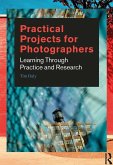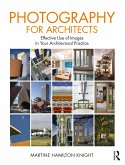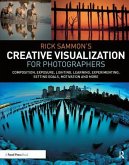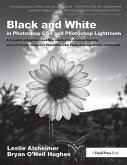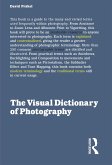James Ewing (USA Brooklyn)
Follow the Sun
A Field Guide to Architectural Photography in the Digital Age
James Ewing (USA Brooklyn)
Follow the Sun
A Field Guide to Architectural Photography in the Digital Age
- Broschiertes Buch
- Merkliste
- Auf die Merkliste
- Bewerten Bewerten
- Teilen
- Produkt teilen
- Produkterinnerung
- Produkterinnerung
Follow the Sun will guide you through all aspects of architectural photography, from the genre's rich history to the exciting new approaches brought by the advent of the digital age. It explains how to use the powerful tools of digital photography while employing many of the skills and traditions of the established genre. Written to be accessible to professionals, amateurs, and students alike, this book will be useful for photographers exploring architecture as fine artists, on editorial assignments, or on commercial shoots.
Andere Kunden interessierten sich auch für
![Practical Projects for Photographers Practical Projects for Photographers]() Tim DalyPractical Projects for Photographers31,99 €
Tim DalyPractical Projects for Photographers31,99 €![Photography for Architects Photography for Architects]() Martine Hamilton KnightPhotography for Architects49,99 €
Martine Hamilton KnightPhotography for Architects49,99 €![What Becomes a Legend Most What Becomes a Legend Most]() Philip GefterWhat Becomes a Legend Most24,99 €
Philip GefterWhat Becomes a Legend Most24,99 €![Rick Sammon's Creative Visualization for Photographers Rick Sammon's Creative Visualization for Photographers]() Rick SammonRick Sammon's Creative Visualization for Photographers189,99 €
Rick SammonRick Sammon's Creative Visualization for Photographers189,99 €![Black and White in Photoshop CS4 and Photoshop Lightroom Black and White in Photoshop CS4 and Photoshop Lightroom]() Leslie AlsheimerBlack and White in Photoshop CS4 and Photoshop Lightroom253,99 €
Leslie AlsheimerBlack and White in Photoshop CS4 and Photoshop Lightroom253,99 €![Queer Methodology for Photography Queer Methodology for Photography]() Asa Johannesson (UK University of Brighton)Queer Methodology for Photography201,99 €
Asa Johannesson (UK University of Brighton)Queer Methodology for Photography201,99 €![The Visual Dictionary of Photography The Visual Dictionary of Photography]() David PrakelThe Visual Dictionary of Photography35,99 €
David PrakelThe Visual Dictionary of Photography35,99 €-
-
-
Follow the Sun will guide you through all aspects of architectural photography, from the genre's rich history to the exciting new approaches brought by the advent of the digital age. It explains how to use the powerful tools of digital photography while employing many of the skills and traditions of the established genre. Written to be accessible to professionals, amateurs, and students alike, this book will be useful for photographers exploring architecture as fine artists, on editorial assignments, or on commercial shoots.
Hinweis: Dieser Artikel kann nur an eine deutsche Lieferadresse ausgeliefert werden.
Hinweis: Dieser Artikel kann nur an eine deutsche Lieferadresse ausgeliefert werden.
Produktdetails
- Produktdetails
- Verlag: Taylor & Francis Ltd
- Seitenzahl: 188
- Erscheinungstermin: 25. Oktober 2016
- Englisch
- Abmessung: 254mm x 177mm x 17mm
- Gewicht: 576g
- ISBN-13: 9780415747011
- ISBN-10: 0415747015
- Artikelnr.: 46765731
- Herstellerkennzeichnung
- Libri GmbH
- Europaallee 1
- 36244 Bad Hersfeld
- gpsr@libri.de
- Verlag: Taylor & Francis Ltd
- Seitenzahl: 188
- Erscheinungstermin: 25. Oktober 2016
- Englisch
- Abmessung: 254mm x 177mm x 17mm
- Gewicht: 576g
- ISBN-13: 9780415747011
- ISBN-10: 0415747015
- Artikelnr.: 46765731
- Herstellerkennzeichnung
- Libri GmbH
- Europaallee 1
- 36244 Bad Hersfeld
- gpsr@libri.de
James Ewing is an award-winning photographer of architecture, landscapes, and interiors. His work has been featured in publications such as Architect, Architectural Record, Metropolis, Architectural Digest, Wallpaper, Icon, Azure, Surface, l'Architecture d'Aujourd'hui, A+U, and The New York Times, among others. James is the recipient of the 2010 and 2014 American Photographic Artists (APA) top prize for Architectural Photography. He has taught photography at CUNY Kingsborough Community College, Oakland Community College, and Indiana University School of Fine Arts. He lives in Brooklyn, New York.
PART 1: Background
Chapter 1: What is Architectural Photography?
1.1 Who needs architectural images and why?
1.2 Various approaches and styles create subjective visions.
1.3 The photographer's role as both promoter and critic of the built
environment.
Chapter 2: A Brief History
2.1 Influence of Linear Perspective
2.2 The Continuous Evolution of Photographic Tools
2.3 A Timeline of Architectural Photography
2.4 Illustration in Both Analog and Digital Images
PART 2: Planning and Preparation
Chapter 3: The Assignment
3.1 Defining an Assignment
3.2 Self-Assigned Work
3.3 Commissioned Work
3.4 Assignment and Voice
Chapter 4: Know The Site
4.1 Access and Permissions
4.2 Mapping the Site
4.3 Working Shot List
4.4 Site Visit and Revised Shot List
4.5 Scheduling
Chapter 5: Follow the Sun
5.1 Rhythms of Earth and Sun
5.2 Qualities of Light
5.3 Light for Architecture
5.4 Sun Tracking Software
5.5 Chronological Shot List
Chapter 6: The Tools of The Trade
6.1 Camera Support
6.2 Lens
6.3 Camera Body
6.4 Camera Case
6.5 Computers and Storage
6.6 Accessories
6.7 Grip kit
6.8 Lighting
PART 3: The Shoot
Chapter 7: Workflow Onsite
7.1 Shooting Checklist
7.2 Photo Assistant
7.3 Keeping Images Safe
7.4 Shooting Tethered
Chapter 8: Composition
8.1 Formal Elements
8.2 Fundamental Variables
8.3 Cultural Components
8.4 Building a Shot
Chapter 9: Perspective and the Tilt-Shift Lens
9.1 Linear Perspective
9.2 Tilt-Shift Lens and Perspective
9.3 Using a Tilt-Shift Lens for Architecture
9.4 Optimizing Sharpness
9.5 Using a Tilt to Extend Focus
9.6 Breaking the z Axis
Chapter 10: Translating Interior Space
10.1 Identify Goals
10.2 Consider Light and Timing
10.3 Select Camera Position, Lens, and Frame
10.4 Style the Room, Move and Edit Objects
10.5 Adjust Existing Light
10.6 Test, Revise, and Take Final Shot
PART 4: The Final Image
Chapter 11: Post Production Workflow
11.1 Download to Delivery
11.2 Hardware for Post-Production
11.3 Software for Post-Production
11.4 Archiving
11.5 Editing, the Selection Process
11.6 Basic Raw Processing
Chapter 12: Advanced Retouching
12.1 Working with a Professional Retoucher
12.2 How much is too much? Choosing a look
12.3 Lightroom Local Adjustments; Gradients and Brushes
12.4 Compositing with Masked Adjustment Layers
12.5 Lens Corrections
12.6 Spotting and Sharpening
Chapter 13: Presentation
13.1 Editing a Portfolio
13.2 Portfolio Website
13.3 Print Portfolio
PART 5: Work in Action
Chapter 14: Voices From the Field
14.1 Peter Aaron
14.2 Magda Biernat
14.3 Ty Cole
14.4 Elizabeth Felicella
Chapter 1: What is Architectural Photography?
1.1 Who needs architectural images and why?
1.2 Various approaches and styles create subjective visions.
1.3 The photographer's role as both promoter and critic of the built
environment.
Chapter 2: A Brief History
2.1 Influence of Linear Perspective
2.2 The Continuous Evolution of Photographic Tools
2.3 A Timeline of Architectural Photography
2.4 Illustration in Both Analog and Digital Images
PART 2: Planning and Preparation
Chapter 3: The Assignment
3.1 Defining an Assignment
3.2 Self-Assigned Work
3.3 Commissioned Work
3.4 Assignment and Voice
Chapter 4: Know The Site
4.1 Access and Permissions
4.2 Mapping the Site
4.3 Working Shot List
4.4 Site Visit and Revised Shot List
4.5 Scheduling
Chapter 5: Follow the Sun
5.1 Rhythms of Earth and Sun
5.2 Qualities of Light
5.3 Light for Architecture
5.4 Sun Tracking Software
5.5 Chronological Shot List
Chapter 6: The Tools of The Trade
6.1 Camera Support
6.2 Lens
6.3 Camera Body
6.4 Camera Case
6.5 Computers and Storage
6.6 Accessories
6.7 Grip kit
6.8 Lighting
PART 3: The Shoot
Chapter 7: Workflow Onsite
7.1 Shooting Checklist
7.2 Photo Assistant
7.3 Keeping Images Safe
7.4 Shooting Tethered
Chapter 8: Composition
8.1 Formal Elements
8.2 Fundamental Variables
8.3 Cultural Components
8.4 Building a Shot
Chapter 9: Perspective and the Tilt-Shift Lens
9.1 Linear Perspective
9.2 Tilt-Shift Lens and Perspective
9.3 Using a Tilt-Shift Lens for Architecture
9.4 Optimizing Sharpness
9.5 Using a Tilt to Extend Focus
9.6 Breaking the z Axis
Chapter 10: Translating Interior Space
10.1 Identify Goals
10.2 Consider Light and Timing
10.3 Select Camera Position, Lens, and Frame
10.4 Style the Room, Move and Edit Objects
10.5 Adjust Existing Light
10.6 Test, Revise, and Take Final Shot
PART 4: The Final Image
Chapter 11: Post Production Workflow
11.1 Download to Delivery
11.2 Hardware for Post-Production
11.3 Software for Post-Production
11.4 Archiving
11.5 Editing, the Selection Process
11.6 Basic Raw Processing
Chapter 12: Advanced Retouching
12.1 Working with a Professional Retoucher
12.2 How much is too much? Choosing a look
12.3 Lightroom Local Adjustments; Gradients and Brushes
12.4 Compositing with Masked Adjustment Layers
12.5 Lens Corrections
12.6 Spotting and Sharpening
Chapter 13: Presentation
13.1 Editing a Portfolio
13.2 Portfolio Website
13.3 Print Portfolio
PART 5: Work in Action
Chapter 14: Voices From the Field
14.1 Peter Aaron
14.2 Magda Biernat
14.3 Ty Cole
14.4 Elizabeth Felicella
PART 1: Background
Chapter 1: What is Architectural Photography?
1.1 Who needs architectural images and why?
1.2 Various approaches and styles create subjective visions.
1.3 The photographer's role as both promoter and critic of the built
environment.
Chapter 2: A Brief History
2.1 Influence of Linear Perspective
2.2 The Continuous Evolution of Photographic Tools
2.3 A Timeline of Architectural Photography
2.4 Illustration in Both Analog and Digital Images
PART 2: Planning and Preparation
Chapter 3: The Assignment
3.1 Defining an Assignment
3.2 Self-Assigned Work
3.3 Commissioned Work
3.4 Assignment and Voice
Chapter 4: Know The Site
4.1 Access and Permissions
4.2 Mapping the Site
4.3 Working Shot List
4.4 Site Visit and Revised Shot List
4.5 Scheduling
Chapter 5: Follow the Sun
5.1 Rhythms of Earth and Sun
5.2 Qualities of Light
5.3 Light for Architecture
5.4 Sun Tracking Software
5.5 Chronological Shot List
Chapter 6: The Tools of The Trade
6.1 Camera Support
6.2 Lens
6.3 Camera Body
6.4 Camera Case
6.5 Computers and Storage
6.6 Accessories
6.7 Grip kit
6.8 Lighting
PART 3: The Shoot
Chapter 7: Workflow Onsite
7.1 Shooting Checklist
7.2 Photo Assistant
7.3 Keeping Images Safe
7.4 Shooting Tethered
Chapter 8: Composition
8.1 Formal Elements
8.2 Fundamental Variables
8.3 Cultural Components
8.4 Building a Shot
Chapter 9: Perspective and the Tilt-Shift Lens
9.1 Linear Perspective
9.2 Tilt-Shift Lens and Perspective
9.3 Using a Tilt-Shift Lens for Architecture
9.4 Optimizing Sharpness
9.5 Using a Tilt to Extend Focus
9.6 Breaking the z Axis
Chapter 10: Translating Interior Space
10.1 Identify Goals
10.2 Consider Light and Timing
10.3 Select Camera Position, Lens, and Frame
10.4 Style the Room, Move and Edit Objects
10.5 Adjust Existing Light
10.6 Test, Revise, and Take Final Shot
PART 4: The Final Image
Chapter 11: Post Production Workflow
11.1 Download to Delivery
11.2 Hardware for Post-Production
11.3 Software for Post-Production
11.4 Archiving
11.5 Editing, the Selection Process
11.6 Basic Raw Processing
Chapter 12: Advanced Retouching
12.1 Working with a Professional Retoucher
12.2 How much is too much? Choosing a look
12.3 Lightroom Local Adjustments; Gradients and Brushes
12.4 Compositing with Masked Adjustment Layers
12.5 Lens Corrections
12.6 Spotting and Sharpening
Chapter 13: Presentation
13.1 Editing a Portfolio
13.2 Portfolio Website
13.3 Print Portfolio
PART 5: Work in Action
Chapter 14: Voices From the Field
14.1 Peter Aaron
14.2 Magda Biernat
14.3 Ty Cole
14.4 Elizabeth Felicella
Chapter 1: What is Architectural Photography?
1.1 Who needs architectural images and why?
1.2 Various approaches and styles create subjective visions.
1.3 The photographer's role as both promoter and critic of the built
environment.
Chapter 2: A Brief History
2.1 Influence of Linear Perspective
2.2 The Continuous Evolution of Photographic Tools
2.3 A Timeline of Architectural Photography
2.4 Illustration in Both Analog and Digital Images
PART 2: Planning and Preparation
Chapter 3: The Assignment
3.1 Defining an Assignment
3.2 Self-Assigned Work
3.3 Commissioned Work
3.4 Assignment and Voice
Chapter 4: Know The Site
4.1 Access and Permissions
4.2 Mapping the Site
4.3 Working Shot List
4.4 Site Visit and Revised Shot List
4.5 Scheduling
Chapter 5: Follow the Sun
5.1 Rhythms of Earth and Sun
5.2 Qualities of Light
5.3 Light for Architecture
5.4 Sun Tracking Software
5.5 Chronological Shot List
Chapter 6: The Tools of The Trade
6.1 Camera Support
6.2 Lens
6.3 Camera Body
6.4 Camera Case
6.5 Computers and Storage
6.6 Accessories
6.7 Grip kit
6.8 Lighting
PART 3: The Shoot
Chapter 7: Workflow Onsite
7.1 Shooting Checklist
7.2 Photo Assistant
7.3 Keeping Images Safe
7.4 Shooting Tethered
Chapter 8: Composition
8.1 Formal Elements
8.2 Fundamental Variables
8.3 Cultural Components
8.4 Building a Shot
Chapter 9: Perspective and the Tilt-Shift Lens
9.1 Linear Perspective
9.2 Tilt-Shift Lens and Perspective
9.3 Using a Tilt-Shift Lens for Architecture
9.4 Optimizing Sharpness
9.5 Using a Tilt to Extend Focus
9.6 Breaking the z Axis
Chapter 10: Translating Interior Space
10.1 Identify Goals
10.2 Consider Light and Timing
10.3 Select Camera Position, Lens, and Frame
10.4 Style the Room, Move and Edit Objects
10.5 Adjust Existing Light
10.6 Test, Revise, and Take Final Shot
PART 4: The Final Image
Chapter 11: Post Production Workflow
11.1 Download to Delivery
11.2 Hardware for Post-Production
11.3 Software for Post-Production
11.4 Archiving
11.5 Editing, the Selection Process
11.6 Basic Raw Processing
Chapter 12: Advanced Retouching
12.1 Working with a Professional Retoucher
12.2 How much is too much? Choosing a look
12.3 Lightroom Local Adjustments; Gradients and Brushes
12.4 Compositing with Masked Adjustment Layers
12.5 Lens Corrections
12.6 Spotting and Sharpening
Chapter 13: Presentation
13.1 Editing a Portfolio
13.2 Portfolio Website
13.3 Print Portfolio
PART 5: Work in Action
Chapter 14: Voices From the Field
14.1 Peter Aaron
14.2 Magda Biernat
14.3 Ty Cole
14.4 Elizabeth Felicella


